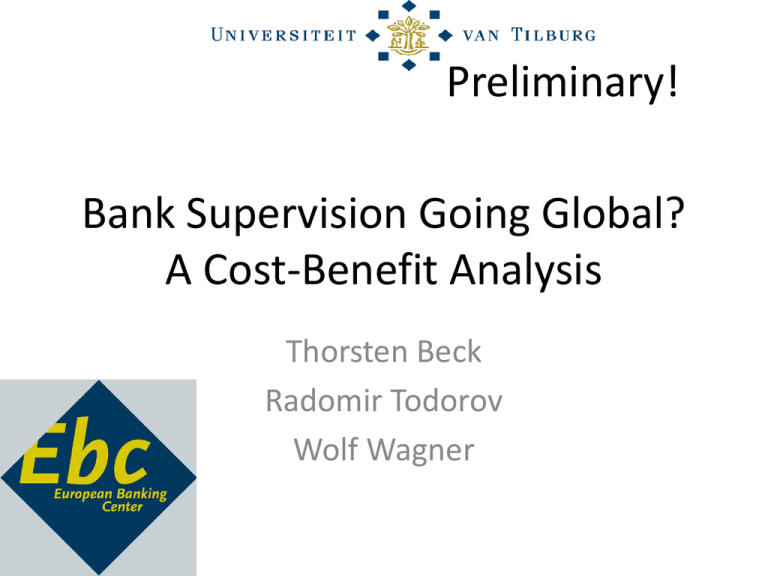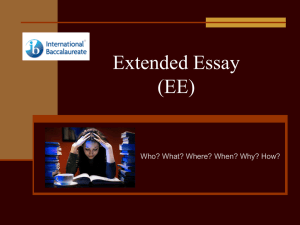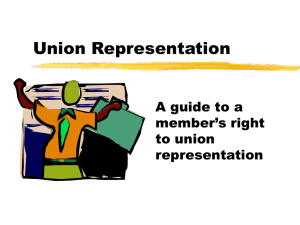presentation
advertisement

Preliminary! Bank Supervision Going Global? A Cost-Benefit Analysis Thorsten Beck Radomir Todorov Wolf Wagner Motivation • Bank failure resolution turned out weak point in recent crisis, especially in case of cross-border banks • “Banks are global in life, national in death” • Recent reform discussion, especially on European level – IMF proposal – EU Commission – Issue of national sovereignty vs. European integration This paper • Simple theoretical model to show the distortions that cross-border activities can introduce in supervisory intervention decision • Highlight costs and benefits of supra-national supervision • Abstract from: capital and other regulation, as well as from moral hazard and market discipline, focus on supervisory discipline Related literature • Capital regulation and cross-border banking (Loranth and Morrison, 2007; Dell’Arriccia and Marquez, 2006; Acharya, 2003) • Importance of ex-ante burden sharing agreements (Freixas, 2003; Goodhart and Schoenmaker, 2009) • Calzolari and Loranth (2010): intervention decision as function of branch vs. subsidiary A simple model • Set-up: one bank, three periods (0,1,2); balance sheet normalized to 1 • No discount factor, interest rate zero • Liabilities: deposits d, equity 1-d • Date 0: Bank invests in illiquid assets • Date 2: assets mature, with prob. l payoff is R>1, with prob. 1- l payoff is zero and external costs c2 • Date 1: supervisor learns prob. l; bank can be liquidated with return 1 and external cost c1 External costs of bank failure • Domino problem – Network, interconnectedness • Hostage problem – Depositors panic – Contagion through payment system • Fridge problem – Destruction of lending relationship, soft information • How to overcome them (minimize c1) – Efficient and swift resolution regime, using merger and acquisition, purchase and assumption, good bank-bad bank etc. Domestic supervisor’s decision • Domestic supervisor: maximizes domestic return (i.e. return to equity and depositors) • Date 1 payoff: 1-c1 • Expected date 2 payoff: lR - (1-l)c2 • Cutoff point: l* = [1-c1+c2]/[ R+c2] • Cutoff decreases in c1 and increases in c2 – Inefficient resolution technique results in higher external costs – External costs increase in size of failing bank and number of failing banks • Assume noisy signal l – as long as symmetric distribution, intervention threshold the same, welfare lower (Type I and Type II errors) Cross-border activities • gD Share of domestic deposits • gE Share of domestic equity • gA Share of domestic assets Decision of home country supervisor l(gDd + gE(R–d)) – (1-l) gAc2 = gDd + gE (1–d) – gAc1 l** = [gDd + gE (1–d) + gA (c2-c1)]/[gDd + gE(R–d)+gAc2] If gD = gE = gA then l* = l** Cross-border activities and intervention decision of national supervisor • If c1=0 intervention threshold l** – Decreases in share of foreign deposits – Increases in share of foreign equity – Decreases in share of foreign asset • If c1>0 intervention threshold l** – Decreases in share of foreign deposits – Increases in share of foreign equity, if c1<< c2 – Decreases in share of foreign assets, if c1<< c2 Branch vs. subsidiary structure • Subsidiary – host country supervisor might be too strict (unless c1 is higher than for domestic banks) • Branch – home country supervisor can only intervene into whole bank; too lenient if high foreign share in assets and deposits (exacerbated if recovery rate in foreign assets less than one) • If lD and lF are different, home supervisor lenient towards negative signals from foreign branches or external failure costs imposed on host country in spite of healthy branch Explaining actual events • Icelandic banks, high foreign assets and deposits, domestic equity – Intervention too late – Other reasons: regulatory/political capture, lack of resources… – Exacerbated through branch structure-host country supervisors had limited information and intervention powers • Fortis: mixed deposits, assets and equity – Belgian supervisor intervened relatively late – Dutch supervisor relatively strict (foreign equity) Supra-national supervisor • Can increase welfare by maximizing return to all equity and deposit holders • But: External costs higher or lower than in case of domestic supervisors? – Resolution in period 1 more difficult as different legal systems and across banking markets – Might have more options for resolution • Signal about l might be noisier for supra-national supervisor, resulting in more type I and type II errors • Supranational supervisor improves welfare more if: – More distortions through higher cross-border activities – Good monitoring and supervision tools – European failure resolution scheme, i.e. tools to intervene and resolve Conclusions • Cross-border activities might distort supervisory intervention decision, but this depends on – What kind of activity (deposit, equity, asset) – Mix • Supra-national resolution authority can improve, but only if equipped with supervision and adequate resolution tools








